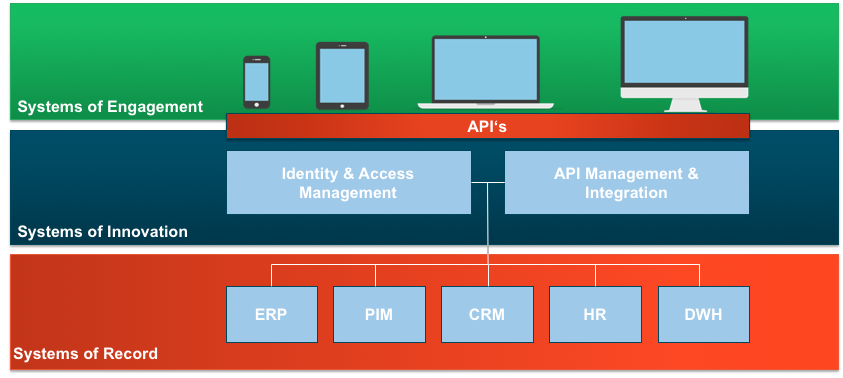The Role of IT in the Age of Digitalisation
Wolfgang Hiemisch - 08.08.2019From Systems of Record to Systems of Engagement
“Systems of engagement begin with a focus on communications. We grew up with letters, phones, telexes, and faxes, and grew into email, shared text databases like Lotus Notes, portals, web sites, and mobile phones. Now we are going to incorporate a third generation of communications, based on 1) connecting people in real time; 2) smart and geographically-aware mobile devices; and 3) ubiquitous and cheap bandwidth.”
"Systems of Engagement and the Future of Enterprise IT"
In classical 'Enterprise IT' over recent decades, large monolithic systems and application suites for data processing, known as 'Systems of Record', were implemented with the task of digitally mapping business processes along the value chain. However, these systems are now considered inflexible, as they contain standard processes ('Best Practice') that can only be adapted to actual business processes ('Own Practice') with considerable effort. Moreover, they are perceived as user-unfriendly, as the logic of user guidance is often oriented towards the data structures and functions of preset workflows. Additionally, each 'System of Record' typically only manages its own domain, meaning that the digitalisation of cross-system processes can often only be accomplished with error-prone asynchronous interfaces. Over time, complex, highly integrated and maintenance-intensive system landscapes have developed which, whilst forming the backbone of today's operational IT, do not meet the requirements for a modern user experience and the desire for individual dynamic adaptability for competitive differentiation.
In contrast, today's expectation of customers, business partners and employees is to be able to contact the company at any time and anywhere using modern, easy-to-use applications, known as 'Systems of Engagement', via different end devices. This shifts the company's focus from a purely transaction-oriented to an interaction-based view of systems, where the communication and collaboration aspect is more prominent than in traditional IT. The challenge for companies now is to connect the 'Systems of Engagement' with the 'Systems of Record', i.e. to create interfaces through which data and services can be published externally without compromising the security and stability of the existing 'Enterprise IT'. This requires a 'mediation layer' between 'Systems of Record' and 'Systems of Engagement', which enables new digital capabilities to be provided quickly, scalably, reusably and channel-independently. The components of this mediation layer are the so-called 'Systems of Innovation'.
Systems of Innovation

Two essential 'Systems of Innovation' are 'Identity and Access Management' and 'API Management & Integration'. They are the core components for connecting 'Systems of Record' with 'Systems of Engagement':
- 'Identity & Access Management' is responsible for central user administration and access rights control.
- 'API Management & Integration' is responsible for the central provision of services.
Both components interact with each other and ensure controlled access to the data and functions of the connected 'Systems of Record'. The exposure of the consolidated capabilities to the 'Systems of Engagement' occurs exclusively via a device and programming language-independent Service Layer (APIs).
Through the decoupling of 'Systems of Record' and 'Systems of Engagement' via Service Layer, requirements and innovations in user orientation can be implemented more quickly and easily, as the underlying complexity is abstracted through the provision of pre-configured APIs. 'Systems of Innovation' thus enable the necessary agility in developing modern user interfaces that are subject to high rates of change. Simultaneously, they allow for the secure and scalable opening of enterprise IT to the outside world for the purpose of creating new interaction possibilities with people – customers, business partners and employees.
In the future, therefore, IT strategy must focus on 'Systems of Engagement' in addition to 'Systems of Record'. To enable the seamless interaction of both worlds, to develop new digital ecosystems and increase the digital reach of business processes, the IT infrastructure needs to be expanded with 'Systems of Innovation'. Enterprise IT must therefore increasingly deal with hybrid (omnichannel) integration scenarios, an increasing number of channels and (mobile) devices, as well as (public) cloud operating models in various forms (Infrastructure as a Service, Platform as a Service, Software as a Service, etc.). This requires that the 'system thinking' that has become entrenched over the years transforms into holistic 'platform thinking'.